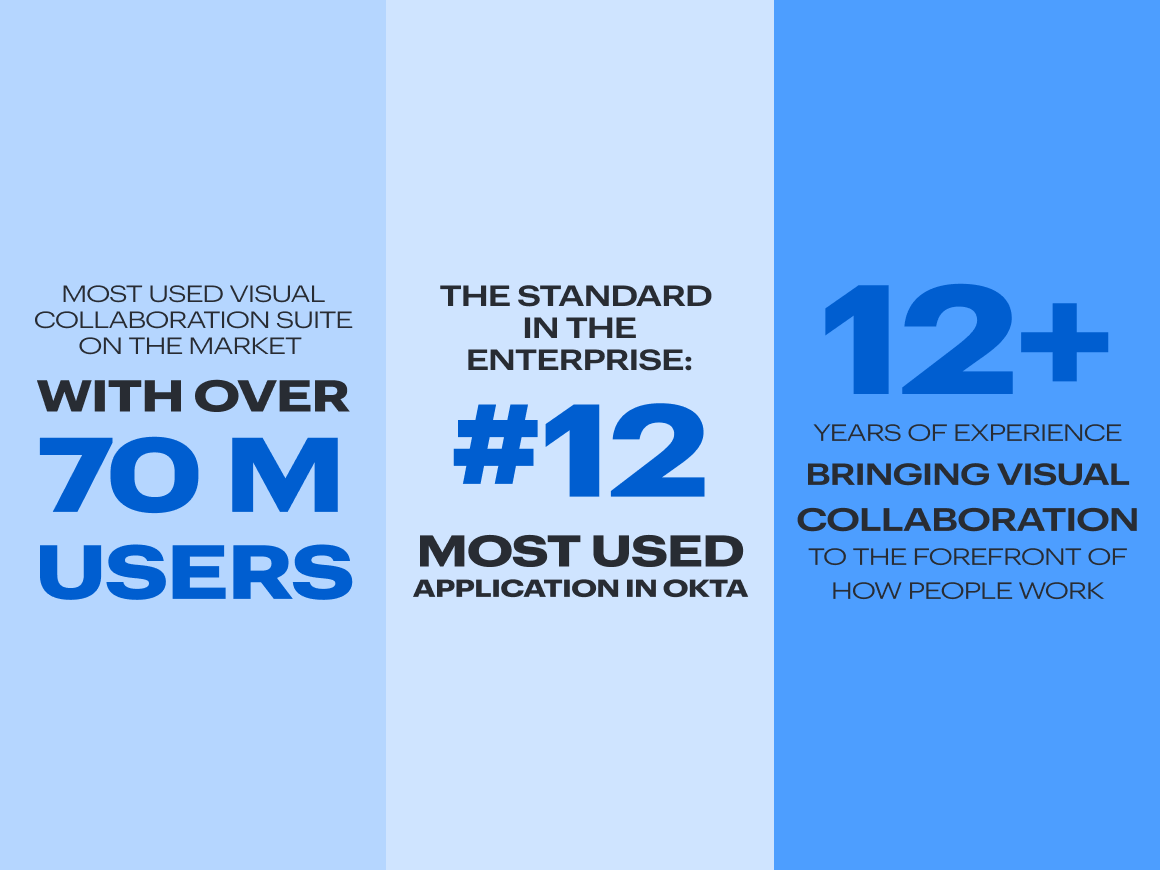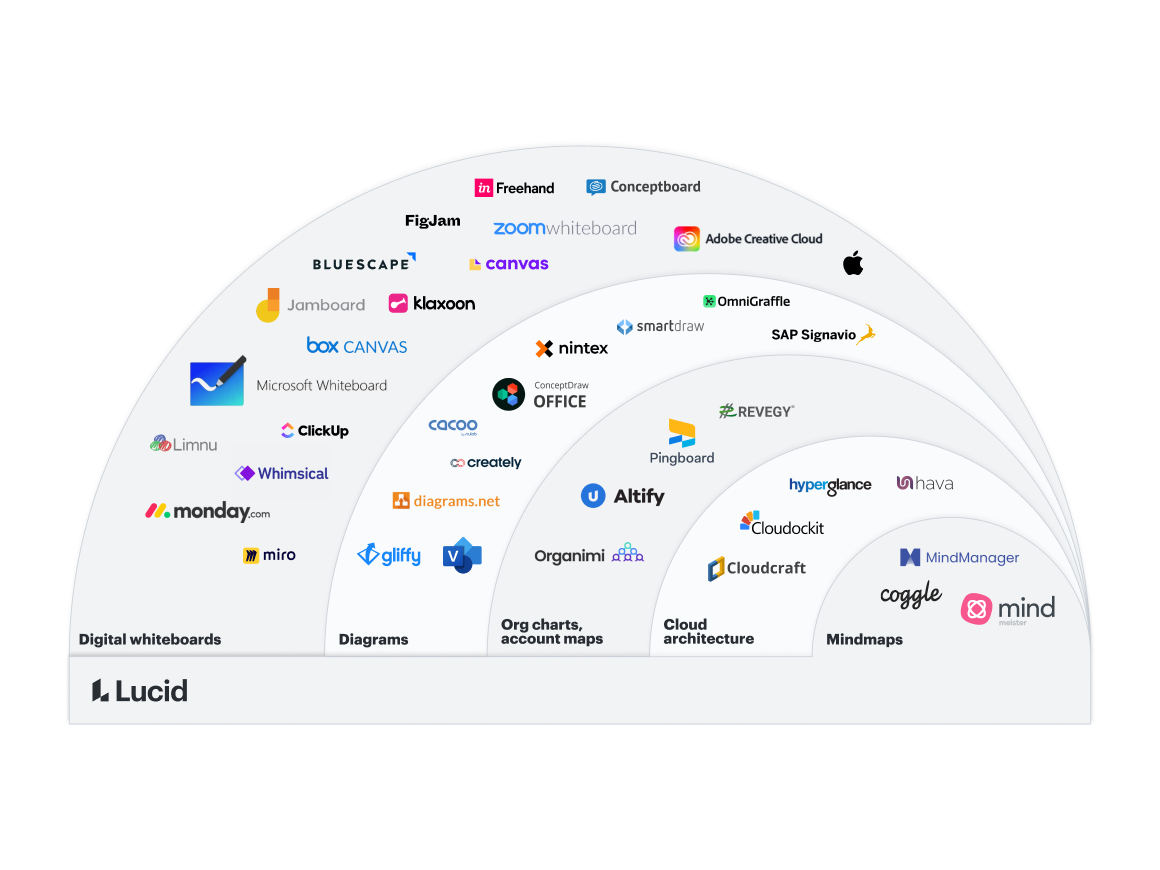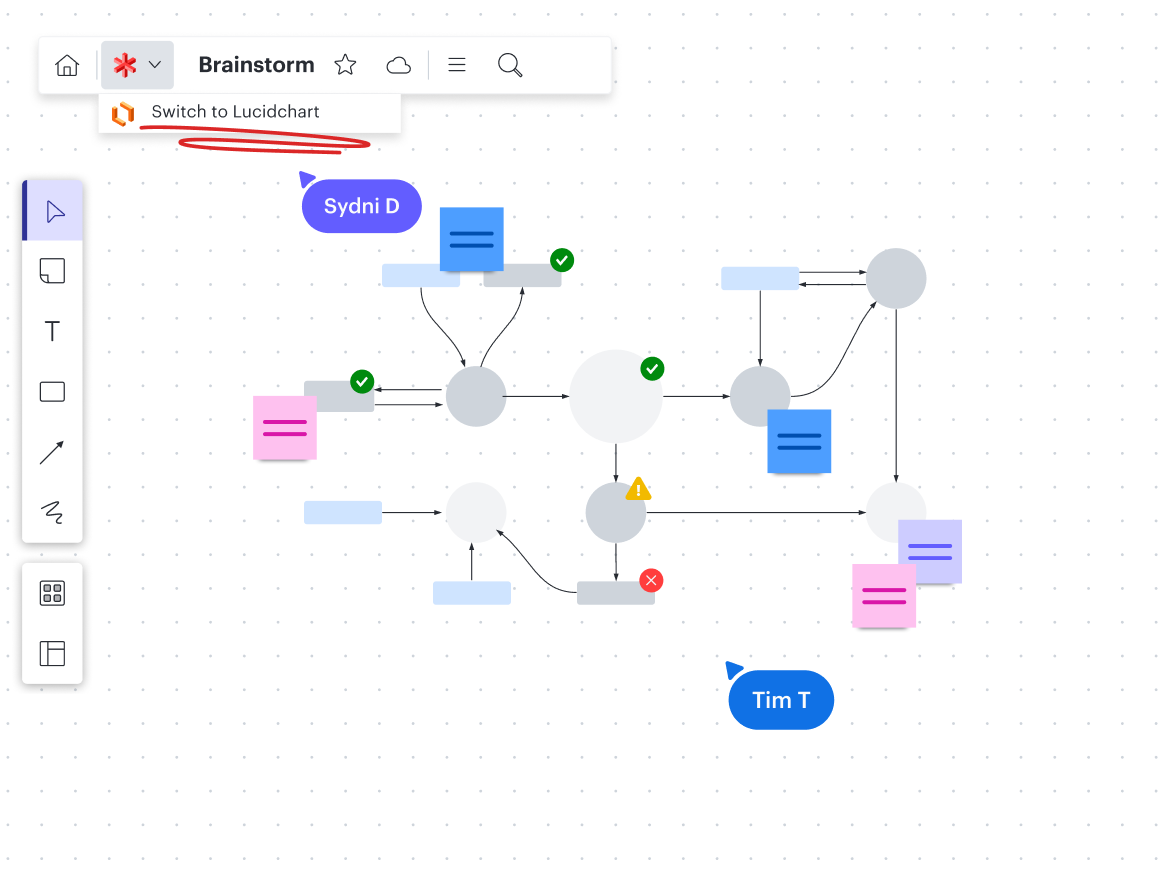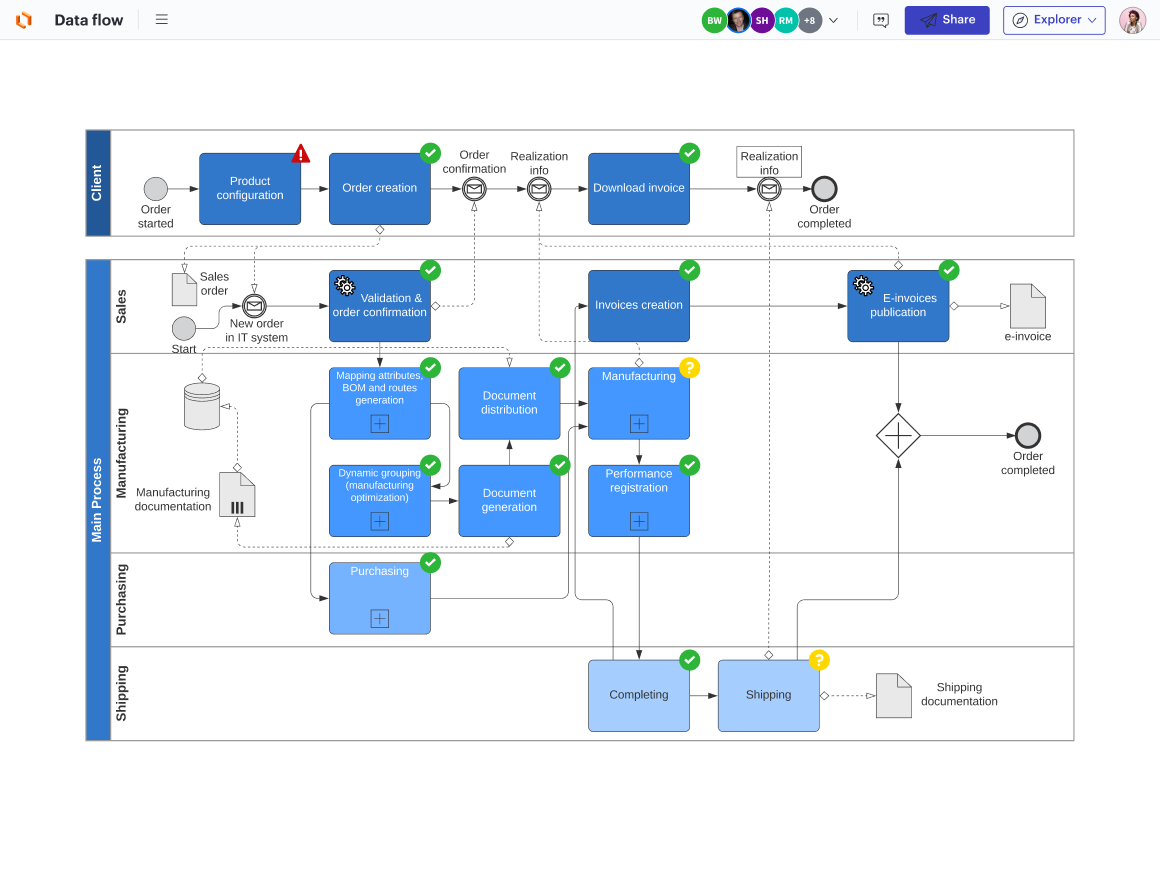
Hidden costs of Miro: Why Lucid is more cost-effective
Reading time: about 9 min
Topics:
Let’s set the stage. Our main characters, Miro and Lucid, are cloud-based visual collaboration platforms that offer a virtual space for teams to come together and create dynamic documentation. Both platforms facilitate the visualization of ideas, processes, systems, campaigns, and more—but they aren’t created equally.
While Miro has virtual whiteboarding capabilities that enable teams to brainstorm, ideate, and plan together in a digital, collaborative space, it leaves critical gaps in terms of smart features and end-to-end workflow support.
Lucid, on the other hand, takes a data-driven, automated, and intelligent approach to its platform, allowing it to meet the needs of every team—from casual diagrammers to highly technical teams. With a dynamic whiteboarding platform and a robust diagramming solution all in one, Lucid supports the entire lifecycle of work, from ideation to execution.
In this article, we’re unveiling the hidden costs of Miro and discussing why Lucid shines as the most cost-effective solution for organizations looking to invest in a visual collaboration platform.
Bird’s-eye view: Comparing Miro vs. Lucid
Lucid’s unique journey sets it apart from its competitors. While Miro started by tackling the virtual whiteboarding concept, Lucid walked a path less traveled.
Lucid’s journey began over a decade ago with a firm focus on intelligence—harnessing the power of data and automation to streamline collaboration. Seeing a large gap in the market, co-founders Ben Dilts and Karl Sun launched Lucidchart to solve the need for streamlined, intelligent, visual diagramming software.
This focus on intelligence guided product decisions as Lucid built Lucidspark, which filled a much-needed space in the market for a dynamic virtual whiteboard, and continues to guide decisions as Lucid launches new features to help teams build.
Because of this initial concentration on intelligent features, seamless integrations, and powerful use cases, Lucid’s approach to whiteboarding is more robust and complete.
Let’s dive into the details of each of these platforms to give us a better comparison.

Functionality
Miro’s offering is straightforward—they provide a virtual whiteboard for teams to digitally collaborate. Teams can quickly dive into the software and start ideating, brainstorming, or planning together. Miro’s features give users a collaborative space to come together, regardless of their physical location, which is a powerful thing in today’s hybrid workforce.
On the other hand, Lucid equips teams with the ability to not only brainstorm and plan, but to then bring those plans to life with automation and robust data visualization, all within a single platform. With Lucid, there's no need to shuffle between other tools in your tech stack and no lost time chasing fragments of information.
Lucid's strength is in bringing together the advanced, deep capabilities within our purpose-built products onto one unified, infinite canvas. That strength is part of what makes Lucid the most used Visual Collaboration Suite on the market with over 70 million users and is the standard in the enterprise.
Okta has reported that more enterprises rely on Lucid than any other Visual Collaboration vendor, and in 2023 they reported that Lucid is the 13th most used enterprise application among Okta customers—far outpacing any other competitor.

Use cases
While Miro offers basic diagramming, it doesn't provide automated data visualization for key use cases like org charts or ERDs.
But with Lucid, teams can automatically convert data from an existing system of record into a visualization to help with more advanced use cases. Lucid also enables teams to create and interpret visuals to build technical diagrams or identify areas of improvement in processes.

Who can use these platforms?
Because Miro's focus is on the initial stages of collaboration, it's primarily used by teams that typically lead out on ideation and planning, such as product management, UX, or design.
However, Miro lacks the capabilities to support deep diagramming and technical use cases. IT, engineering, and solutions architects need advanced functionality, shape libraries, and data capabilities that are not available in Miro to be able to visualize the complex processes and systems they work in every day.
Lucid was created to serve all teams, including those with the most technical, complex use cases (engineering, IT, operations, etc.). Miro and other competitors don’t have the same commitment to intelligence, data, and automation that Lucid does. Inherently, this means that these competitors can fail anyone who’s trying to visualize complex data, systems, and processes.
The dynamic nature of Lucid’s software makes it the only vendor that can service the needs of casual, user-friendly diagramming and deep, technical diagramming in a single platform. Lucid has also applied this dedication to intelligence, data, and automation to virtual whiteboarding.
The hidden costs of Miro: Why Lucid wins
You're after top-notch quality without breaking the bank—we get that. But the hunt for affordability isn't just about the initial price. Cost-effectiveness is about the time, effort, and resources you invest to make a new software solution work seamlessly for your organization.
This is where Miro’s hidden costs become apparent, and Lucid emerges as the clear winner—a powerful and cost-effective visual collaboration solution. Below, you’ll find the three main hidden costs of choosing Miro over Lucid.

1. Scattered information and tool switching
Miro's software leaves gaps that can't cover the whole project journey, causing information to scatter. Scattered information can cause frustration for teams that need a way to work together from start to finish. While different teams may lead different stages of the workflow, everyone involved needs to be able to see context upstream and downstream to better gauge the work to be done, how to do it, and then how it was ultimately implemented when looking back to reference the work for future projects.
Miro’s limitations can lead organizations to need multiple software just to support the entire project workflow. If teams are constantly switching between multiple applications to get their work done, information becomes scattered across tools.
Shockingly, more than a quarter (27%) of workers squander over 10 hours weekly hunting down crucial project intel. Meanwhile, 31% of workers find a glaring gap in their project process: they don’t know where to find essential project resources.
Plus, when teams rely on a multitude of software tools, they add to business complexity. Today's businesses are naturally intricate, leveraging more technology than ever before. As companies connect data, tech, products, services, apps, and people, a complex web emerges. The consequence? Information slips through the cracks, leading to poor organizational alignment.
How Lucid solves this: Tool consolidation
Lucid helps teams consolidate their tech stack and even replaces an average of two tools in a customer's tech stack, with one of them often being Miro. With Lucid, you're giving your teams a central hub that takes them from brainstorming big ideas to rolling up their sleeves for action—all in the same place.
Basically, the days of static, scattered, and outdated documentation are over. Using Lucid to house your entire organization’s documentation—from brainstorming sessions to process improvement plans, technical diagrams, and more—means that you naturally create a living, dynamic, visual, and up-to-date single source of truth. This documentation makes it easier to bring on new hires, avoid institutional knowledge, replicate successful processes, and more.

This kind of innovation repository is priceless to companies, and if you can have that all within one single software license, that’s going to save your organization time, money, and resources.
With Lucid’s universal canvas, creating effortless documentation in a single platform is an even smoother process. This universal canvas allows teams to start a project in Lucidspark, with its streamlined UI and powerful whiteboarding tools, and then switch to the Lucidchart toolkit, with more advanced diagramming, data, and automation capabilities, to start bringing the project to life.

2. Lack of expertise and onboarding support
Miro’s onboarding is lacking, particularly in terms of its migration process. If you're transitioning from another visual collaboration software to Miro, brace yourself for hurdles. Miro doesn’t have the ability to seamlessly switch from other vendors. If you’re looking to switch from an existing platform, this can be a cumbersome process that weighs you down and ends up costing additional time and money.
Miro can’t compare to Lucid’s experience working with technical teams, which means organizations with technical needs won’t get the same level of ongoing expertise.
How Lucid solves this: Dedicated partners
Lucid has an extremely thorough onboarding program and has been focused on supporting and serving technical teams from the very beginning. In terms of ongoing support, Lucid is in it for the long haul.
Whether migrating from another visual collaboration platform or tackling complex business ventures, Lucid's implementation teams are fully dedicated to each account. Moreover, Lucid's professional services team offers an impressive range of over ten unique services, far surpassing what competitors provide.
Having an unparalleled presence spanning diverse teams, best-in-class security features, and centralized control doesn’t hurt, either.
3. Insufficient automation and intelligent systems
Miro lacks intelligent and automation features, both in the virtual whiteboarding and diagramming space. As a result, teams are forced to spend time manually diagramming, updating documentation, interpreting diagrams, and gathering data to make a decision.
Plus, without clear, data-driven visuals, your teams could suffer from slow decision making, which can be incredibly costly. A McKinsey survey of more than 1,200 international business leaders found that inefficient decision-making costs a typical Fortune 500 company 530,000 days of managers’ time, equating to roughly $250 million in annual wages.
Manually carrying out those tasks also introduces room for error, so if teams are making decisions based on manual diagrams, there could be increased risk in the decision that could be costly in the future.
How Lucid solves this: Intelligent data and automation features
Lucid’s intelligent features can help you automate your existing workflows. Features such as data linking, dynamic shapes, conditional formatting, and Visual Activities aid your teams in making faster and more strategic decisions. Automating these processes removes the risk of human error in manual workflows and takes a weight off of your teams’ shoulders.

While Miro offers a glimpse into the power of visual collaboration, Lucid emerges as the industry-leading pioneer of the category and the comprehensive solution organizations should be investing in. Lucid’s commitment to innovating and changing the narrative around modern workflows is unparalleled, and combined with dedication to clients and to their ongoing success, it’s the clear winner.

Ready to get started?
Contact our team today and learn more about how Lucid can empower teams throughout your organization.
Get in touchAbout Lucid
Lucid Software is the leader in visual collaboration and work acceleration, helping teams see and build the future by turning ideas into reality. Its products include the Lucid Visual Collaboration Suite (Lucidchart and Lucidspark) and airfocus. The Lucid Visual Collaboration Suite, combined with powerful accelerators for business agility, cloud, and process transformation, empowers organizations to streamline work, foster alignment, and drive business transformation at scale. airfocus, an AI-powered product management and roadmapping platform, extends these capabilities by helping teams prioritize work, define product strategy, and align execution with business goals. The most used work acceleration platform by the Fortune 500, Lucid's solutions are trusted by more than 100 million users across enterprises worldwide, including Google, GE, and NBC Universal. Lucid partners with leaders such as Google, Atlassian, and Microsoft, and has received numerous awards for its products, growth, and workplace culture.
Related articles
The value of the Lucid Suite: a summary of Forrester’s Total Economic Impact™ study
We commissioned Forrester Consulting to conduct a Total Economic Impact™ study, taking a deep dive into the ROI that enterprises can realize from using Lucid.
5 red flags to look out for when evaluating visual collaboration platforms
Learn how to uncover critical weaknesses in visual collaboration platforms before you commit.
What makes Lucid the most intelligent visual collaboration solution—and why does it matter?
From data-backed visualizations to automation and AI, find out what makes Lucid the most intelligent visual collaboration solution.
The top capabilities technical teams need from a visual collaboration solution
Check out our guide for the best capabilities tech teams should look for in a visual collaboration solution.
